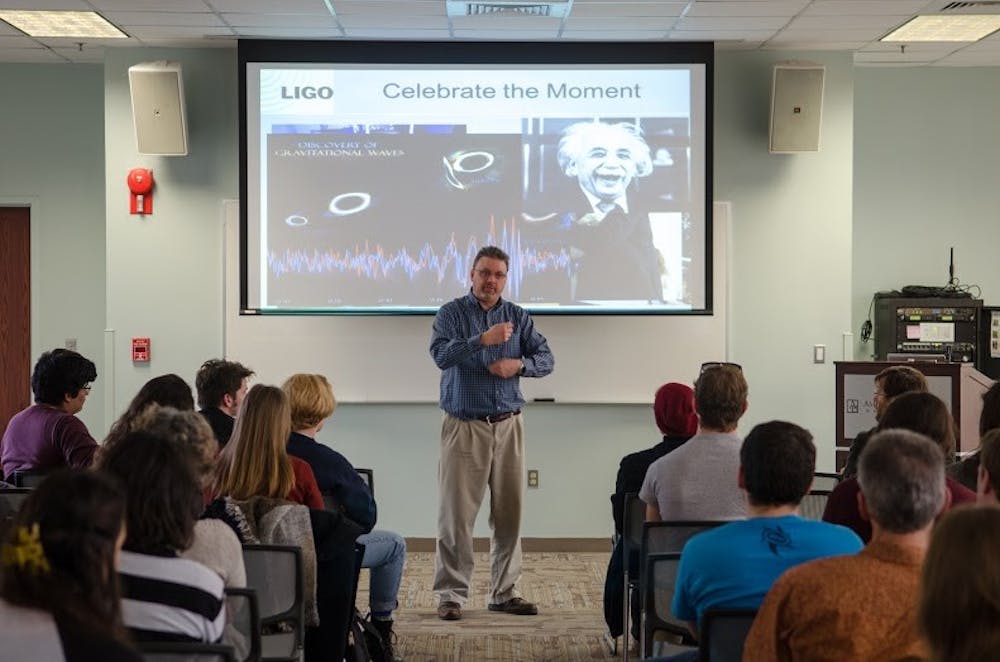When prospective students think of AU, some might picture the School of International Service building or a campus overflowing with political science students. A picture of science labs complete with microscopes and long white coats might not come to mind.
While the AU science programs may not be as well-known, they are strong, successful and growing, as 589 undergraduate students are currently enrolled with primary or secondary majors in the sciences. This includes the construction of a new life sciences building slated to open sometime in 2020. It will be built where the Asbury parking lot is currently situated.
Senior physics major Zach Waldron said the environment within the science department is fun and welcoming.
“The science department is very small, close-knit. All the professors go by their first names, they’re all very personable people,” Waldron said.
When he entered AU as a freshman, Waldron didn’t expect to pursue a major in physics. Instead, he planned to major in psychology, history or philosophy, but then took physics as a general education course and changed his mind.
Since starting physics, he has worked with NASA on heliophysics, tutored AU physics students and assisted with a Physics 100 course.
Peter Starr, Dean of the College of Arts and Sciences, said many AU students also find themselves drawn to the sciences.
“The biology major in particular has grown a lot, the B.S. in Public Health has grown, neuroscience is now at 51 majors, so we’re beginning to get a real critical mass of science undergraduate students,” Starr said.
Ulysses J. Sofia, associate dean of research for the College of Arts and Sciences, said there has also been a growth in funding in the science programs, including money from the National Institute of Health and the National Science Foundation.
“The provost has several times made large allocations of [University] funds available to help buy core facilities, instrumentation that will be used by multiple faculty members, to get them some of the basic instrumentation so they can apply for more grants,” Sofia said. “The grant activity in sciences has gone up by many factors since this growth started nine years ago. Many more of our scientists are getting funded from more agencies than we were [then].”
Funding for research is important for faculty members such as Gregg Harry. Harry is part of the Laser Interferometer Gravitational-Wave Observatory, which works on detecting gravitational waves. Gravitational waves are predictions of Einstein’s theory of gravity and are caused by large astronomical objects such as black holes. Last February, LIGO observed gravitational waves for the very first time, confirming Einstein’s 1915 theory and attracting international attention.
Harry works with undergraduate physics students in a small lab on campus conducting research on properties of the mirrors used in the detectors of gravitational waves.
“Understanding the mirrors and the optics [of the gravitational wave detectors] is really crucial, so we have samples of mirror material and things like that that we can characterize, and try and come up with better materials and understand the materials we do have,” Harry said.
Before coming to AU in 2011, Harry did research at MIT. While there, he missed interacting with students and decided to come to D.C. to teach. Harry has since seen a continuous growth in the science programs at AU and thinks that will continue to happen in the coming years.
“A lot of the people that are being hired are very active in some very cutting-edge fields,” Harry said. “A lot of the new faculty are bringing some very exciting research to campus. There’s also talk of a PhD program in the life sciences, which is crucial for doing impactful research.”
Dean Starr said that there is currently one PhD program in the sciences, but the provost has talked about adding one or two more once the life sciences building opens and is able to support another PhD program.
Starr believes new facilities on campus will impact the growth of science at AU, as the current resources have become inadequate to sustain the level of predicted growth.
“While we have grown the size of the science faculty quite remarkably over the last nine years, we are now at a point where we really don’t have the facilities to grow the science faculty anymore,” Starr said.
He noted that the new Don Meyers Technology and Innovation Building on East Campus will become the home for several of the science departments and bring the faculty and students closer together.
The expansion of the sciences will allow AU to compete with the facilities and programs of similar universities and will give science students plenty of opportunities to expand on their education.
“We’re bringing ourselves up to what our peers are of our size. We did an analysis and looked at other schools that have the same undergraduate population that we have and said, ‘Okay how many people do they have in physics, in chemistry, in biology?”, Sofia said. “We said, ‘how big are we supposed to be compared to these other schools that we would like to be like?’”
Olivia Bell and Erin Swartz, both juniors majoring in biology, noted how the smaller size of the program has allowed them to work closely with professors, but acknowledged that new facilities are needed.
“I knew I wanted to do science coming into college, and what drew me to AU was the fact that it was a smaller school and the department was smaller, so the aspect of getting a closer bond with professors was appealing,” Swartz said. “But Hurst [Hall] is so old and it has poor facilities, so a new building is needed.”
“Research brings in money,” Bell said. “In order to get funding and build a good relationship with donors, you need to have stronger hard sciences. The departments are expanding which will promote happier faculty and students and will also attract more prospective students.”





